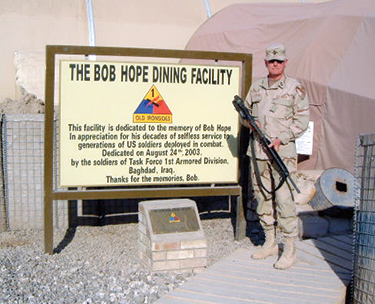For William Kuhns, ’73, public affairs is no boring desk job
 In 2004, a 59-year-old Army sergeant named Clarence Kugler enjoyed a few moments of minor celebrity as the “oldest enlisted soldier in Iraq”—a title, he jokingly told the Los Angeles Times, that no one was likely to challenge him for.
In 2004, a 59-year-old Army sergeant named Clarence Kugler enjoyed a few moments of minor celebrity as the “oldest enlisted soldier in Iraq”—a title, he jokingly told the Los Angeles Times, that no one was likely to challenge him for.
The coverage drew chuckles from another sergeant stationed in Iraq, William Kuhns, ’73, who is two months Kugler’s senior. “I had my 60th birthday in Baghdad,” Kuhns says.
That’s the mandatory retirement age for most noncommissioned officers, but Kuhns, a public-affairs specialist with the Washington Army National Guard, is on an age waiver that will allow him to complete 20 years of service and receive a military pension. He’ll retire in 2007, at the age of 62, although he says he’s unlikely to be deployed again. In February, after a yearlong tour of duty in Iraq, he returned to Seattle and his full-time job teaching art and photography at Nathan Hale High School.
As it happens, Kuhns didn’t come forward to challenge Kugler’s claim. A modest, somewhat taciturn man, he seems to prefer staying behind the scenes. In Baghdad he ran the 122nd Mobile Public Affairs Detachment, supervising the work of print and broadcast journalists for a variety of military media. He also provided support for the public-affairs arm of the First Cavalry Division, headed by Major General Peter Chiarelli, ’80 (see “To Baghdad and Back,” June 2005), and facilitated battlefield coverage opportunities for civilian reporters.
That may sound like an appropriately low-risk assignment for a 60-year-old soldier, but Kuhns says it was by no means a desk job. “Public affairs people go wherever anything is going on,” he says. “And out on the road, as you know, is the most dangerous place to be.” On one occasion, a suicide bomber tried to ram the shuttle bus in which Kuhns and some other soldiers were riding. He narrowly missed, and the car blew up in the road right behind them. “That kind of affected my blood pressure,” Kuhns says.
Kuhns isn’t entirely sanguine about such experiences, but he’s no stranger to them, either. His first military deployment was to Vietnam, where he served as an Army signal company commander in 1969 and 1970. He has also notched eight-month tours with peacekeeping forces in Bosnia and Kosovo.
But despite this résumé, Kuhns isn’t a career military man. After Vietnam, he left the service for nearly two decades, earning a master’s in art education from the UW and devoting himself full-time to his teaching. “But in the back of my mind,” he says, “I missed some aspects of [military life]—the camaraderie, I think.” In 1989, a friend who was planning to try a one-year stint in the National Guard encouraged Kuhns to sign up as well. “At my age, it was pretty much the last moment I could’ve done it,” Kuhns says. “And so I did it. And my buddy tried it for a year and got out, and I’ve been in ever since.”
He says his transition from the classroom to the combat zone and back has been fairly smooth, in part because he’s done it before. “My students are all aware of the fact that I was there,” he says, “and they’ll ask me questions once in a while. But I pretty much focus on my art and photography. I don’t do a big show and tell or anything.”